Top 12 Tools for Tracking Scope 3 Supplier Emissions (2025)
Karel Maly
August 3, 2025
For organisations committed to meaningful decarbonisation, tackling Scope 3 emissions is the most significant and complex challenge. These indirect emissions, originating from the value chain, often constitute the largest portion of a company's carbon footprint. The primary obstacle is the lack of visibility-how can you manage emissions you can't accurately measure across hundreds or thousands of suppliers? This is where specialised software becomes essential, moving beyond spreadsheets to provide scalable, auditable, and actionable data.
This guide is designed to help you navigate the crowded market of tools for tracking Scope 3 supplier emissions. We will provide a detailed, practical analysis of 12 leading platforms, moving beyond marketing claims to offer a clear view of their real-world capabilities. For each tool, we will examine core features, integration methods, ideal use cases, and honest limitations. Many of these platforms are also incorporating advanced analytics; understanding the broader applications of AI in supply chain management can provide valuable context for how these technologies are evolving.
Our goal is straightforward: to equip you with the insights needed to select the right platform for your specific operational needs and regulatory requirements. Each entry includes screenshots and direct links, allowing you to efficiently evaluate and compare the best solutions available.
1. Carbonpunk
Best for: Enterprises with complex global supply chains seeking AI-driven optimisation.
Carbonpunk positions itself as a premier AI-driven carbon management platform, making it one of the most powerful tools for tracking Scope 3 supplier emissions, especially for organisations with intricate logistics networks. It excels at transforming raw operational data into strategic, actionable insights. The platform’s core strength lies in its ability to seamlessly integrate with logistics providers and process large datasets via automated CSV uploads, delivering highly accurate (over 95%) real-time emissions data.
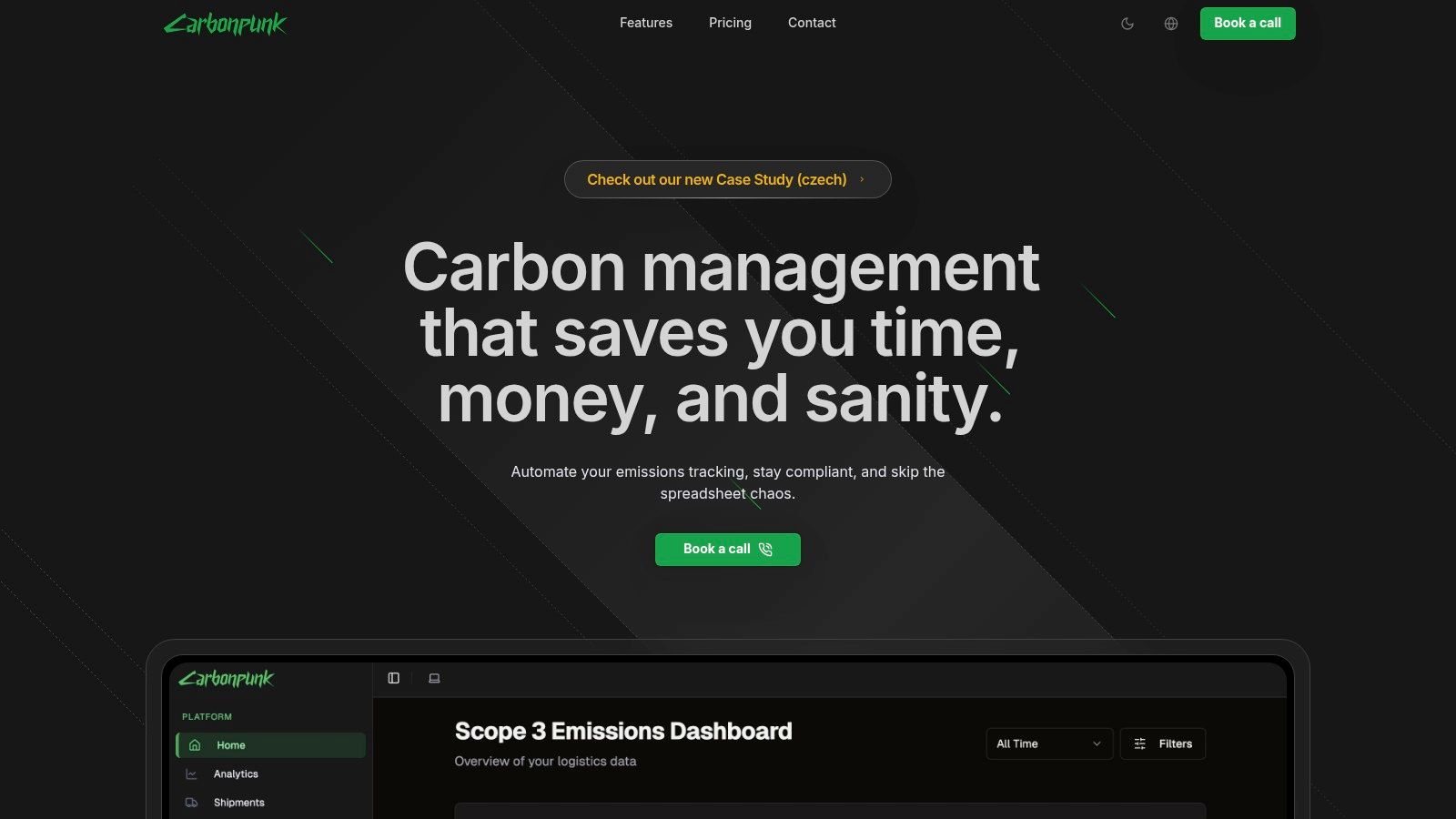
Unlike many platforms that simply report historical data, Carbonpunk's AI engine provides predictive analytics and prescriptive recommendations. This includes identifying optimal transport routes and suggesting alternative, lower-emission transport modes, empowering logistics managers to make immediate, impactful changes. For sustainability officers, the platform automates the creation of audit-ready reports compliant with major frameworks like the GHG Protocol, TCFD, and CDP, significantly reducing the manual effort tied to regulatory compliance and stakeholder reporting.
Key Strengths and Use Cases
- High-Fidelity Data Integration: The system’s direct integration capabilities ensure a continuous flow of validated data, eliminating the reliance on outdated or incomplete supplier information. A practical use case involves a multinational retailer using Carbonpunk to get real-time emissions data from its dozens of freight partners, unifying disparate information into a single, reliable dashboard.
- AI-Powered Emission Reduction: Its analytics engine goes beyond tracking to actively recommend efficiency improvements. For example, a manufacturing firm could use the platform to analyse its distribution network and receive AI-generated advice to shift specific shipments from air to sea freight, with precise forecasts on cost and carbon savings.
- Automated, Compliant Reporting: The platform automates the generation of complex ESG reports, a critical function for public companies and those facing stringent regulatory oversight. This ensures reports are not only accurate but also fully aligned with evolving global standards, saving hundreds of hours for compliance teams.
Practical Considerations
While its capabilities are extensive, Carbonpunk is primarily architected for large-scale operations. Smaller businesses might find the feature set too robust for their needs. Pricing is not publicly available and requires a direct consultation to obtain a customised quote based on the complexity and scale of the supply chain.
Website: https://www.carbonpunk.ai/en
2. Plan A
Plan A offers a certified carbon accounting platform specifically designed to help businesses manage their decarbonisation journey. Its software is engineered to streamline the complex process of emissions tracking, making it an excellent starting point for organisations new to sustainability reporting or those needing to align with evolving regulations. The platform automates data collection from internal teams and external suppliers, simplifying one of the most labour-intensive aspects of Scope 3 analysis.
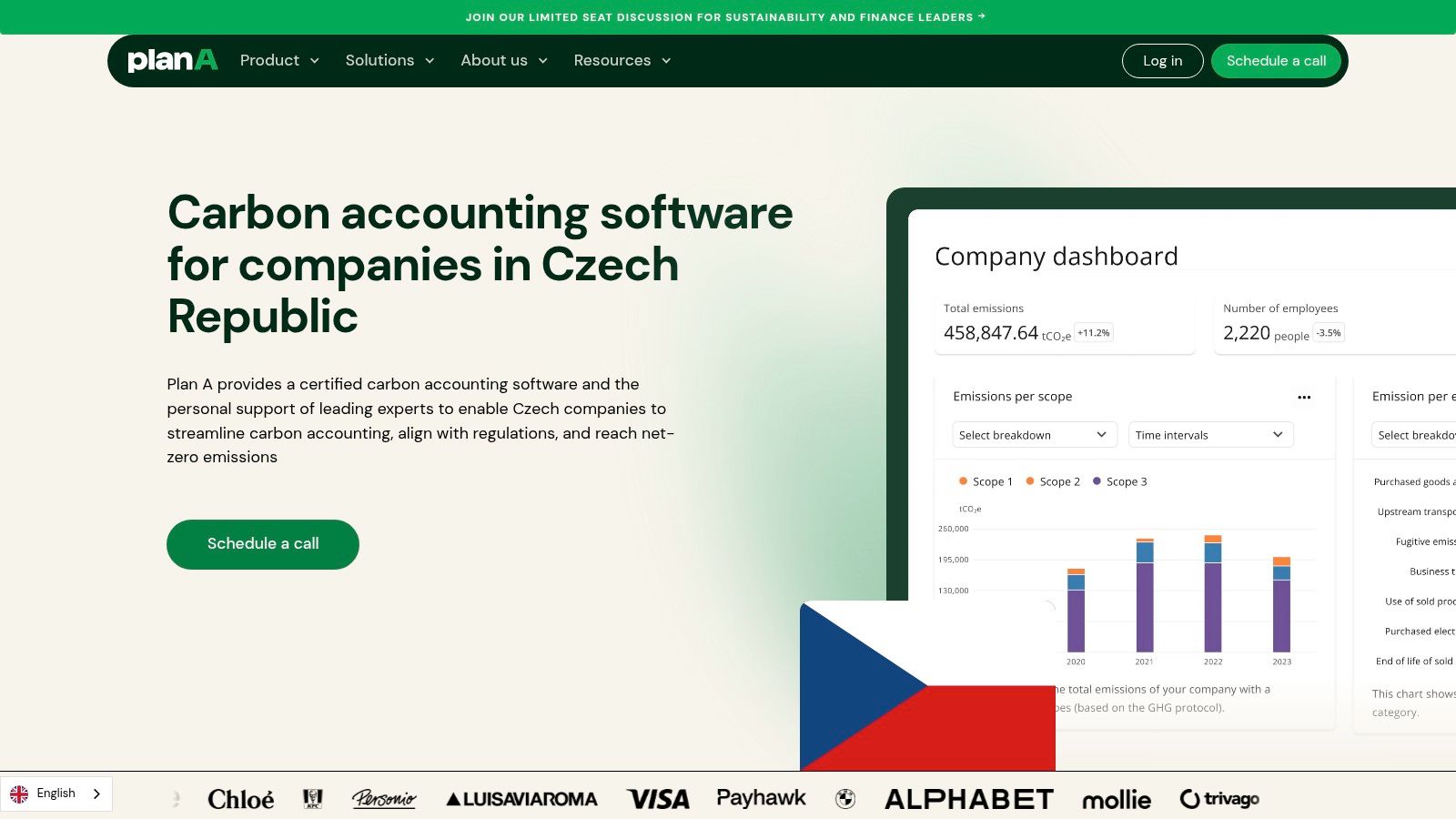
The platform stands out for its strong focus on regulatory compliance, particularly for European standards like the Corporate Sustainability Reporting Directive (CSRD). This makes it one of the more robust tools for tracking Scope 3 supplier emissions for companies operating within or supplying to the EU.
Key Features & Use Case
Plan A’s system is built around a user-friendly interface that translates complex emissions data into actionable insights through customisable dashboards. A key use case involves a procurement manager using the platform to identify high-emission suppliers and collaborate on reduction initiatives, supported by science-based targets set within the tool.
| Feature Highlights | Practical Application |
|---|---|
| Automated Data Collection | Reduces manual effort in gathering supplier activity data. |
| Regulatory Compliance Support | Prepares businesses for CSRD and other mandatory disclosures. |
| Science-Based Target Setting | Helps create a clear, credible roadmap for decarbonisation. |
Access and Implementation
To get started, organisations must request a demo through the Plan A website to discuss pricing and implementation, which is customised based on company size and complexity. While the initial data integration from various supplier systems can require a dedicated setup period, the platform’s support team guides users through the process. Its intuitive design minimises the learning curve, though advanced analytics may require some user training.
3. Sweep
Sweep offers a scalable carbon management platform designed for enterprises with complex value chains, focusing on collaborative data collection and reduction strategies. It enables businesses to manage emissions across all 15 Scope 3 categories by engaging suppliers directly through the platform. This approach not only streamlines data gathering but also fosters a shared sense of responsibility for decarbonisation, moving beyond simple compliance.

The platform’s strength lies in its ability to facilitate large-scale supplier engagement, offering free access for suppliers to submit their data and collaborate on initiatives. This makes it one of the most effective tools for tracking Scope 3 supplier emissions for organisations aiming to drive tangible reductions throughout their supply network. For a deeper understanding of this process, you can explore this Scope 3 emissions tracking guide for enterprise teams.
Key Features & Use Case
Sweep is engineered for collaboration, allowing sustainability managers to set shared reduction targets with key suppliers and monitor progress together. A common use case involves a multinational corporation using Sweep to onboard hundreds of suppliers, segmenting them by emissions impact, and launching targeted campaigns to improve data quality and co-develop low-carbon procurement policies.
| Feature Highlights | Practical Application |
|---|---|
| Collaborative Supplier Portal | Provides a free, shared space for suppliers to input data and track progress. |
| Enterprise-Grade Security | SOC 2 and ISO 27001 compliance ensures data is secure and audit-ready. |
| Full Scope 3 Coverage | Collects and analyses data across all 15 upstream and downstream categories. |
Access and Implementation
Organisations can request a demo via the Sweep website to explore its features and discuss a customised implementation plan. The initial setup can be resource-intensive, particularly for businesses with vast and diverse supplier ecosystems, as it involves significant data mapping and supplier onboarding. However, the platform's collaborative design is intended to simplify this over time as more suppliers actively participate.
- Website: https://www.sweep.net/
4. Persefoni
Persefoni delivers a sophisticated carbon accounting and management platform tailored for large enterprises and financial institutions requiring audit-ready emissions reporting. Its system is engineered to manage the immense data complexity of global supply chains, translating vast datasets into compliant, decision-useful climate disclosures. The platform automates Scope 3 calculations using both spend-based and activity-based methodologies, offering flexibility and precision for intricate value chains.

The platform’s key distinction lies in its finance-first approach, integrating climate data directly into financial workflows and risk management. This positions it as one of the most effective tools for tracking Scope 3 supplier emissions for organisations that must align sustainability with investment-grade reporting standards like the SEC, CSRD, and ISSB.
Key Features & Use Case
Persefoni’s interface is designed for users familiar with financial reporting systems, providing a strong audit trail and data controls. A primary use case involves a Chief Financial Officer using the platform to assess the carbon footprint of their investment portfolio (Scope 3, Category 15) and prepare for mandatory climate disclosures, ensuring data integrity and defensibility.
| Feature Highlights | Practical Application |
|---|---|
| Automated Scope 3 Calculations | Leverages both spend and activity data for comprehensive supplier analysis. |
| Built-in Regulatory Alignment | Generates reports pre-formatted for SEC, CSRD, and ISSB filings. |
| Strong Audit Trail & Controls | Ensures data is transparent, traceable, and ready for third-party assurance. |
Access and Implementation
Accessing Persefoni requires scheduling a demo via its website for a customised quote, as pricing is geared towards enterprise-level needs. Implementation is a structured process, often supported by partners like PwC, to ensure seamless integration with existing ERP and financial systems. While its premium cost may be a barrier for smaller companies, its robust feature set and compliance focus provide significant value for regulated industries and large corporations.
- Website: https://www.persefoni.com/
5. Greenly
Greenly offers a dynamic carbon accounting platform designed to help businesses, particularly small to medium-sized enterprises (SMEs) and mid-market companies, measure, reduce, and offset their carbon footprint. The software automates much of the data collection process by integrating with a company's financial systems and using its vast emissions factor database to match spending data with carbon estimates. This makes it an efficient tool for gaining an initial, comprehensive view of Scope 3 emissions.
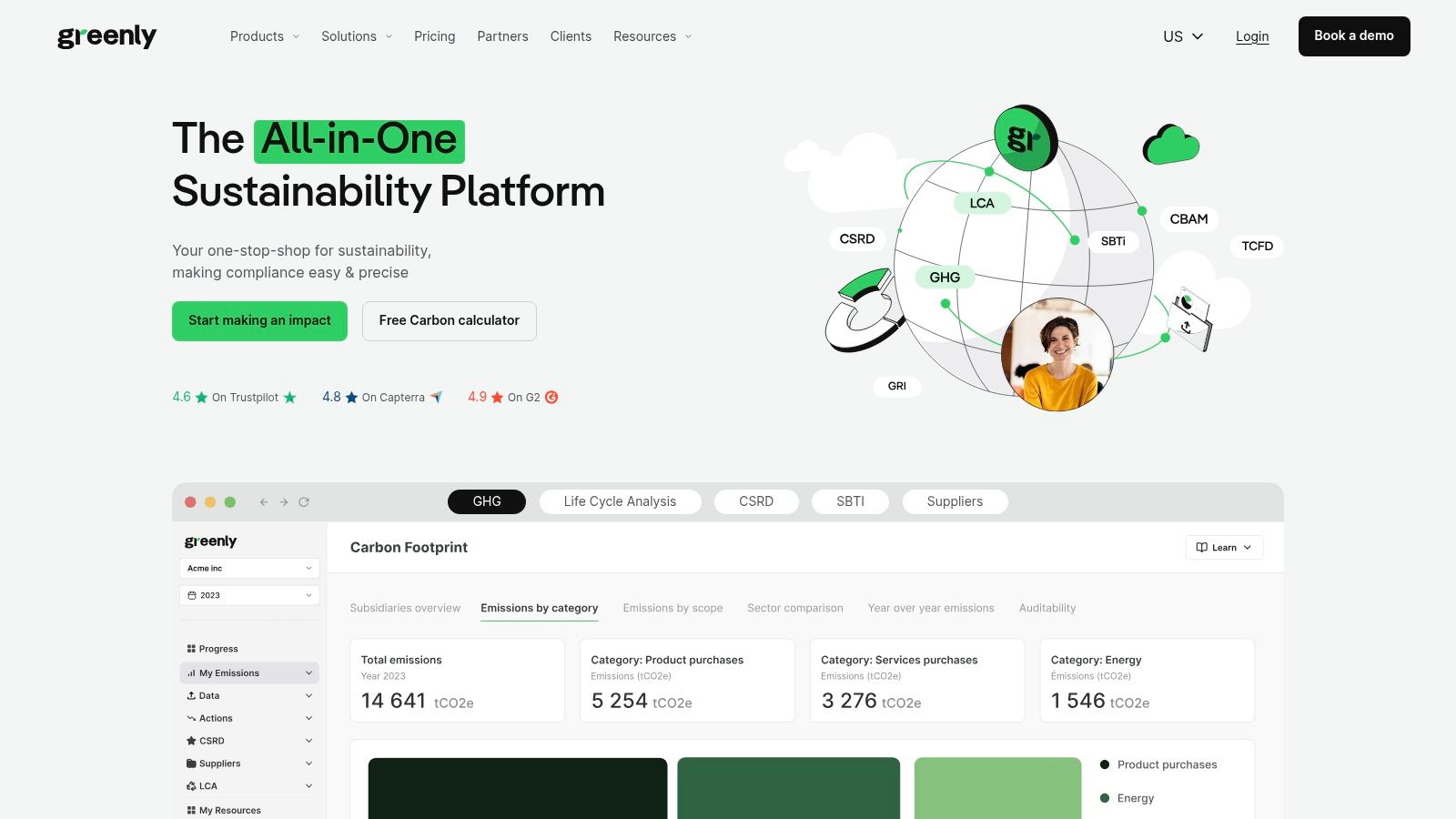
The platform’s strength lies in its blend of automation and guided action. It not only calculates a company’s footprint but also provides a dedicated climate expert to help interpret the results and formulate a reduction plan. This makes Greenly one of the more supportive tools for tracking Scope 3 supplier emissions, especially for organisations that lack in-house sustainability expertise.
Key Features & Use Case
Greenly excels at turning complex financial data into a clear carbon footprint analysis. A key use case is for a finance or operations manager to sync company spending data, automatically identifying emission hotspots within the supply chain. From there, they can use Greenly's custom supplier questionnaires to gather primary data and collaborate on reduction initiatives, supported by regulatory-ready reports for CSRD and TCFD.
| Feature Highlights | Practical Application |
|---|---|
| Automated Supplier Matching | Quickly estimates supplier emissions using financial data. |
| Dedicated Climate Expert | Provides personalised guidance for decarbonisation strategies. |
| Regulatory-Ready Reports | Simplifies compliance with frameworks like CSRD and CBAM. |
Access and Implementation
Getting started with Greenly involves requesting a demo via their website to receive a customised quote based on company size and specific needs. The implementation process is designed to be fast, often leveraging financial data integrations for a quick initial carbon footprint. While the automated approach is highly efficient, refining the data with supplier-specific information requires engagement through the platform's tools. The user interface is clean and intuitive, minimising the need for extensive training.
- Website: greenly.earth/
6. Sphera
Sphera provides a comprehensive Scope 3 Emissions Calculator designed to measure emissions intensity with high precision, focusing on data from individual supplier manufacturing sites. Its approach centres on gathering facility-level energy use data, which it then automatically converts into greenhouse gas emissions intensities. This granular method allows for a more accurate and defensible emissions profile compared to platforms that rely solely on industry averages or spend-based estimates.
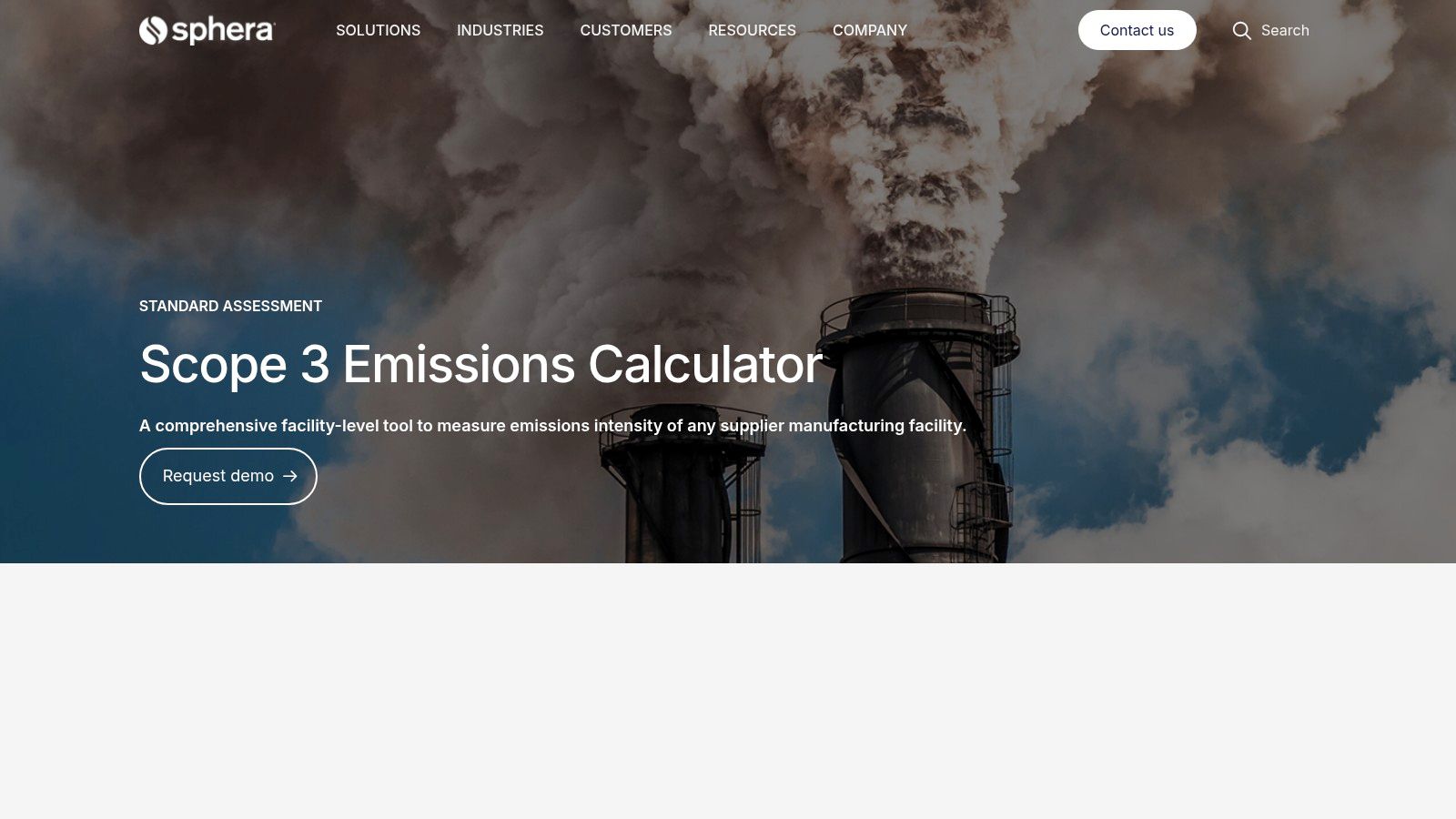
The platform is particularly valuable for organisations aiming for deep supply chain engagement and data quality. By requesting specific energy data, it encourages suppliers to improve their own monitoring capabilities. This makes it one of the more powerful tools for tracking Scope 3 supplier emissions for businesses committed to achieving verifiable reductions and mastering their overall supply chain visibility.
Key Features & Use Case
Sphera's system is built for detailed analysis, offering multi-tier assessment capabilities to look beyond direct suppliers. A key use case involves a sustainability manager using the platform to identify specific high-emitting facilities within a single supplier's network. This allows for targeted collaboration on energy efficiency projects rather than generic, company-wide requests, leading to more impactful outcomes.
| Feature Highlights | Practical Application |
|---|---|
| Facility-Level Data Input | Calculates emissions based on actual energy use for higher accuracy. |
| Automated GHG Conversion | Simplifies the complex task of turning raw energy data into emissions figures. |
| Multi-Tier Assessment | Provides visibility into the emissions of suppliers' suppliers (Tier 2 and beyond). |
Access and Implementation
Access to Sphera’s platform is provided following a consultation and demo, which can be requested through their website. The pricing and implementation plan are customised to the organisation's specific needs. While the initial setup may require a concerted effort to engage suppliers and gather detailed energy data, Sphera's framework is designed to improve supplier response rates over time. The platform’s detailed nature means some initial training will likely be necessary for both internal teams and key suppliers.
7. Emitwise
Emitwise is a carbon accounting platform that leverages machine learning to help businesses measure, report, and reduce their carbon footprint across the entire value chain. Its technology is designed to provide real-time emissions data, moving beyond annual estimates to offer dynamic and actionable insights. The platform automates data collection from various sources, including supplier systems, to deliver precise calculations for complex supply chains.
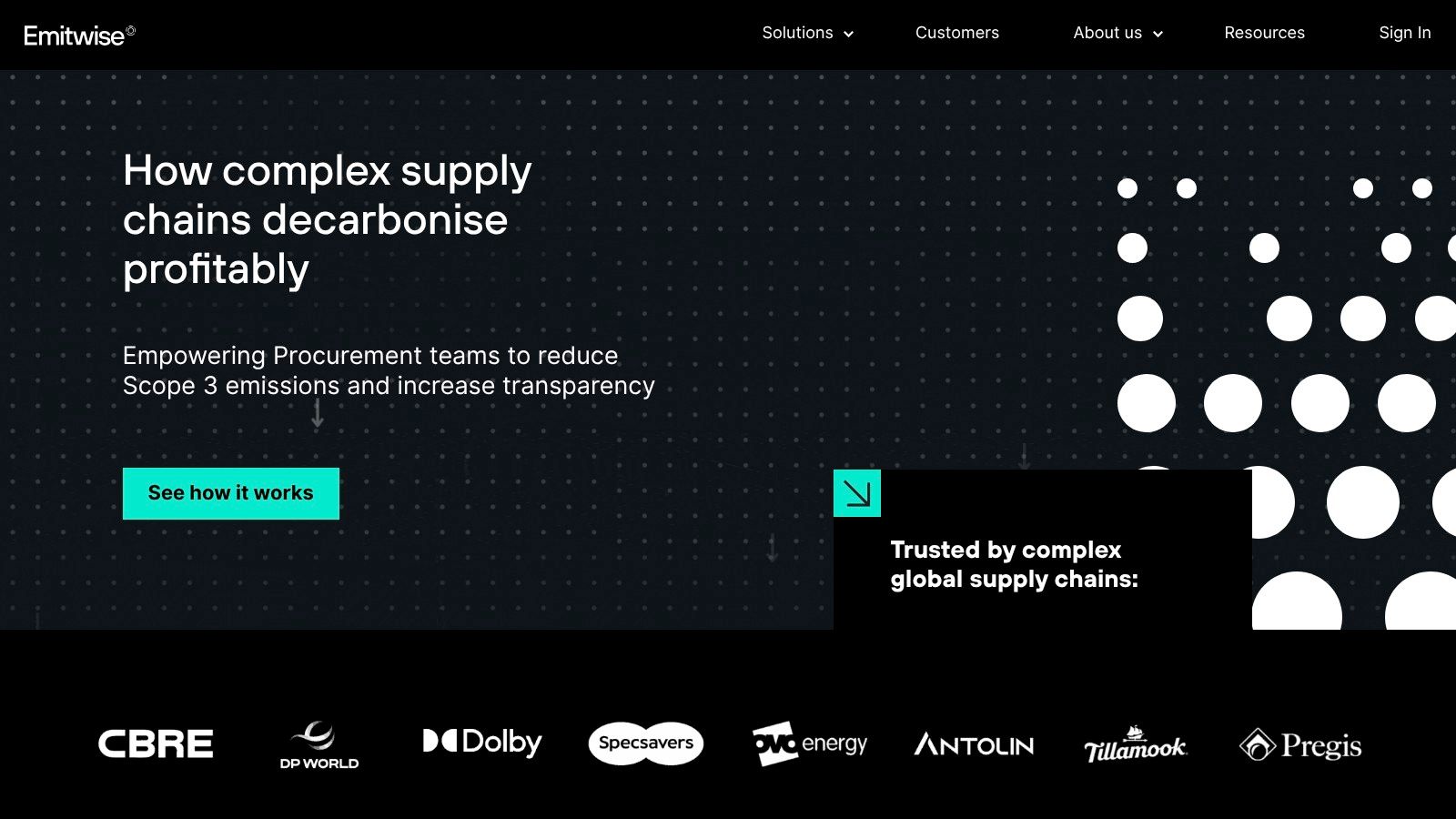
The platform’s standout feature is its use of machine learning to improve data accuracy over time, making it one of the more technologically advanced tools for tracking Scope 3 supplier emissions. This focus on automation and real-time tracking empowers organisations to be more responsive in their decarbonisation efforts and comply with major global reporting frameworks.
Key Features & Use Case
Emitwise is built for continuous carbon management, not just periodic reporting. A primary use case involves a sustainability manager using the platform to monitor supplier emissions in real-time, identifying hotspots as they emerge and engaging directly with those suppliers to implement reduction strategies. The system’s automated processes ensure data is consistently up-to-date for internal and external reporting.
| Feature Highlights | Practical Application |
|---|---|
| Machine Learning Automation | Improves the accuracy of emissions calculations over time with minimal manual input. |
| Supplier-Level Integration | Provides granular data for precise Scope 3 analysis and targeted engagement. |
| Customisable ESG Reporting | Generates audit-ready reports aligned with standards like TCFD, CDP, and GHG Protocol. |
Access and Implementation
To start using Emitwise, businesses need to book a demo via the company website. Pricing is customised based on the organisation's scale and specific needs. While the advanced machine learning features offer significant benefits, they may require some initial technical expertise to integrate fully with existing systems. However, the platform is supported by a dedicated team to guide users through implementation and ensure data integrity from the outset.
- Website: https://www.emitwise.com/
8. Normative
Normative simplifies Scope 3 emissions calculations by using AI to automate the measurement of indirect emissions across complex supply chains. The platform is engineered to process vast amounts of financial transaction data, converting spend into carbon equivalents with minimal manual input. This makes it a powerful tool for large enterprises looking to get a comprehensive yet efficient overview of their entire value chain footprint.
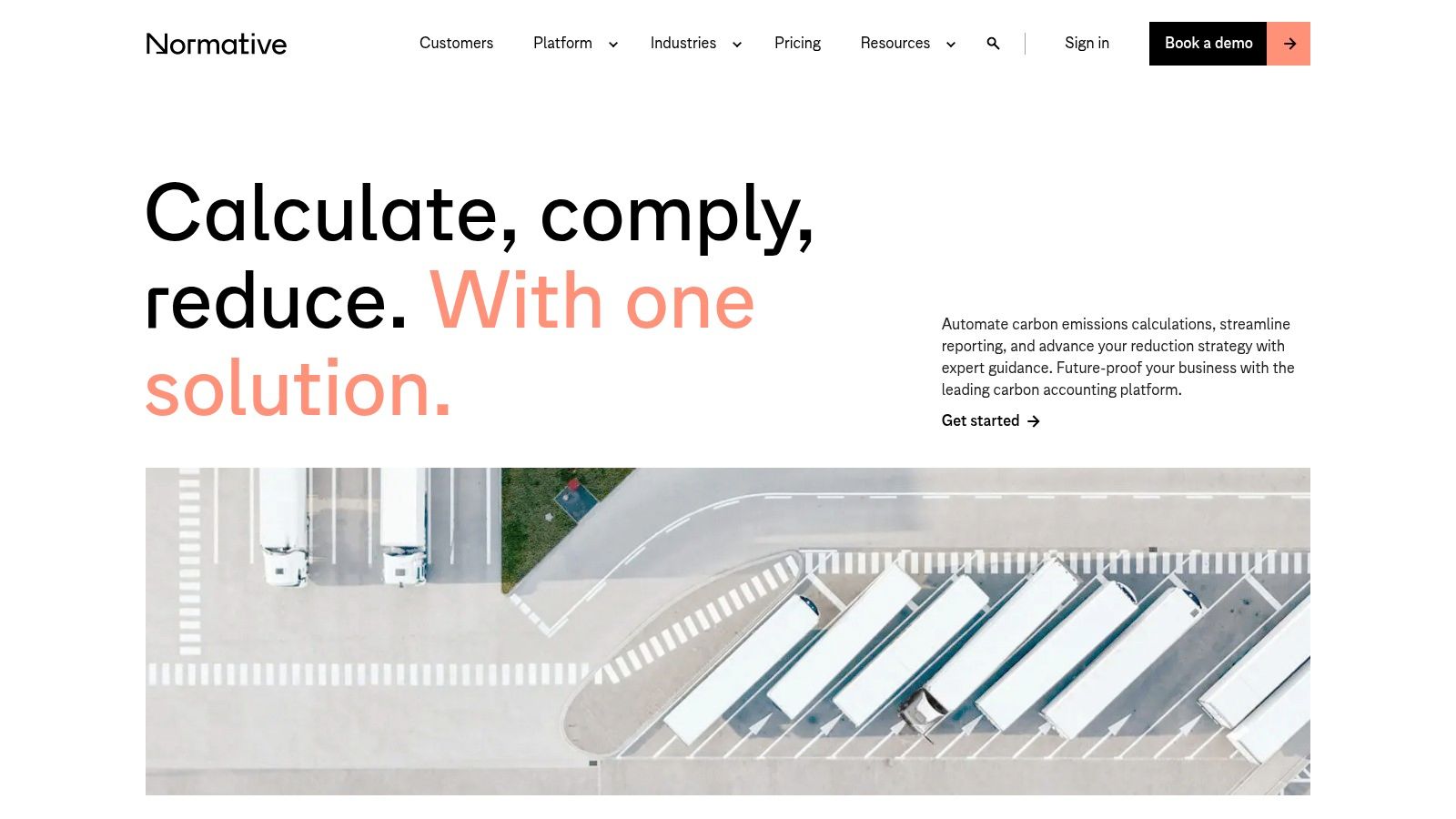
The platform’s core strength lies in its extensive, scientifically-vetted emissions factor database, which enhances the accuracy of spend-based calculations. By automating this process, Normative provides some of the most accessible tools for tracking Scope 3 supplier emissions, especially for organisations that lack granular supplier activity data but have robust financial records.
Key Features & Use Case
Normative excels at providing a top-down view of emissions hotspots. A key use case involves a finance or procurement team uploading expenditure data to quickly identify which supplier categories contribute most significantly to the company's carbon footprint. This initial analysis helps prioritise which suppliers to engage for more detailed data collection and collaborative reduction efforts.
| Feature Highlights | Practical Application |
|---|---|
| Spend-Based Calculation Engine | Quickly maps company spending to carbon emissions across all 15 Scope 3 categories. |
| Extensive Emissions Factor Database | Offers more accurate and reliable calculations than generic models. |
| Automated Reporting | Generates reports aligned with major frameworks like GHG Protocol and CSRD. |
Access and Implementation
Access to Normative’s platform begins with a demo requested through their website, where a tailored plan is developed. Implementation hinges on integrating financial data, which requires close collaboration between sustainability, procurement, and finance teams to ensure data accuracy. While the user interface is designed for clarity, its reliance on financial data models may feel technical for users without a background in carbon accounting.
- Website: normative.io
9. Axiom
Axiom provides a specialised Scope 3 Carbon Calculator designed to bring clarity and speed to emissions management. The platform focuses on streamlining supply chain sustainability efforts by simplifying data collection and promoting effective supplier collaboration. Its core strength lies in translating complex supply chain emissions data into clear, actionable insights, making it a valuable asset for organisations aiming to improve their environmental performance.
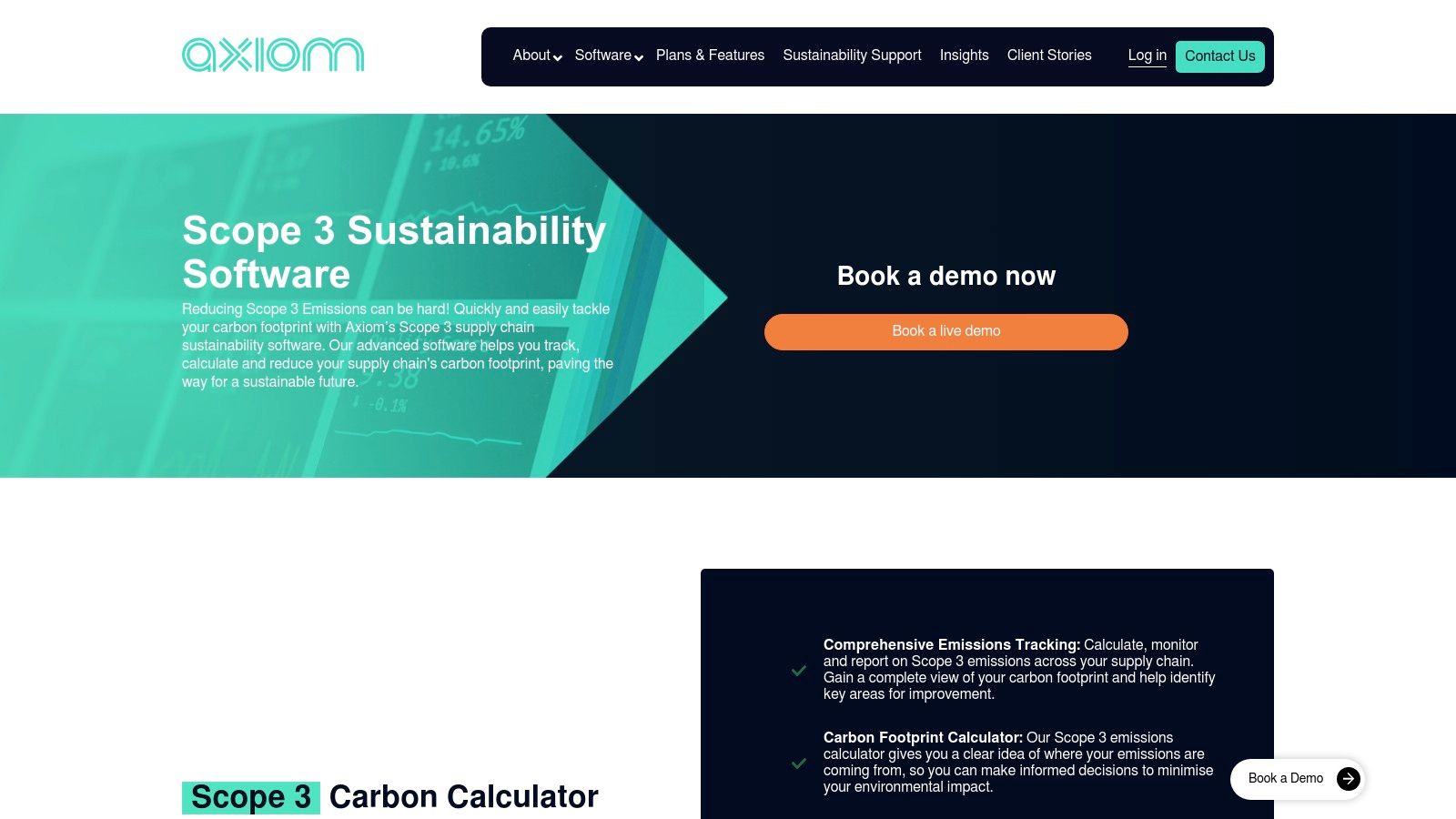
The platform is engineered to be highly customisable, allowing businesses to align its functionalities with their specific operational needs and sustainability goals. This adaptability makes it one of the more flexible tools for tracking Scope 3 supplier emissions, particularly for enterprises seeking a solution that can evolve with their decarbonisation strategy. For more information, explore these expert strategies to reduce supply chain carbon emissions.
Key Features & Use Case
Axiom’s system is built to facilitate direct engagement with suppliers, ensuring the data collected is both accurate and comprehensive. A common use case involves a sustainability manager using the platform to not only calculate the company’s carbon footprint but also to engage directly with key suppliers, identify shared reduction opportunities, and monitor progress towards joint environmental targets.
| Feature Highlights | Practical Application |
|---|---|
| User-Friendly Carbon Calculator | Quickly calculates Scope 3 emissions with a simplified interface. |
| Supplier Collaboration Tools | Enables direct communication and data sharing with supply chain partners. |
| Customisable Data Analysis | Allows businesses to analyse specific sustainability metrics relevant to them. |
Access and Implementation
Organisations can get started with Axiom by visiting its website and requesting a demo to discuss implementation and pricing. The initial setup and data integration may require a dedicated effort and some user training to fully leverage its advanced features. However, the platform is designed to simplify complex emissions data, and its customisability helps align the tool closely with existing business processes for a smoother transition.
10. CarbonTrail
CarbonTrail empowers small and medium-sized enterprises (SMEs) to measure and share verifiable emissions data, focusing on collaborative Scope 3 reporting. Its platform streamlines data sharing between business partners with centralised workflows and AI-powered measurement tools, making it ideal for organisations that work extensively with smaller suppliers who may lack sophisticated reporting systems of their own.
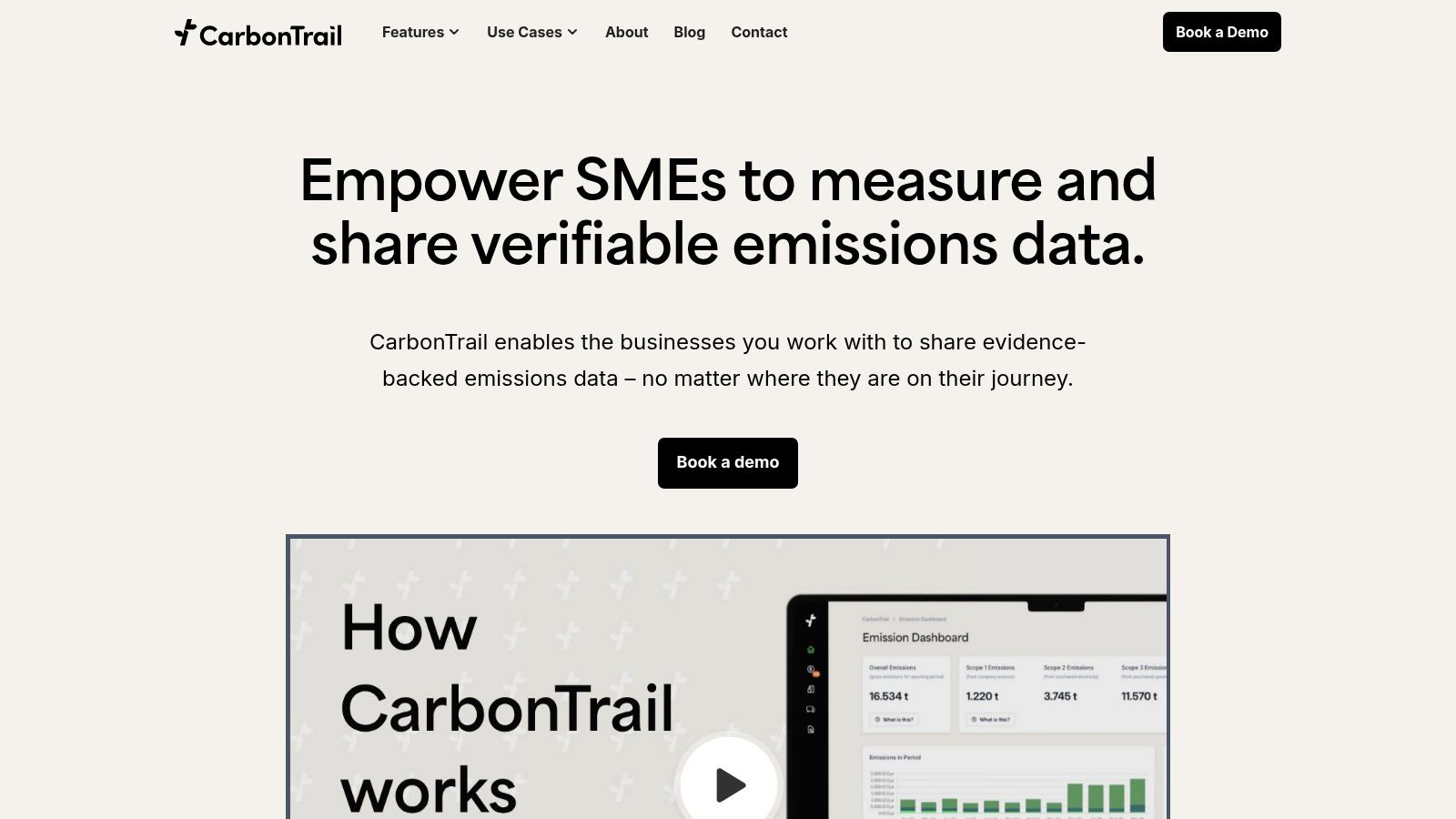
The platform’s strength lies in its engagement-first approach, enabling larger companies to onboard their entire supplier network, including smaller businesses. By providing guided, user-friendly tools, CarbonTrail is one of the more accessible tools for tracking Scope 3 supplier emissions because it helps generate verifiable and comparable data directly from the source, enhancing the accuracy of a company's overall carbon footprint.
Key Features & Use Case
CarbonTrail’s core value is simplifying the supplier engagement process. A primary use case involves a supply chain manager inviting dozens of SME suppliers to the platform. These suppliers are then guided through an AI-powered process to calculate their emissions, which are shared back in a standardised format aligned with the GHG Protocol and ISO14064, ensuring compliance and data integrity.
| Feature Highlights | Practical Application |
|---|---|
| Centralised Workflow | Manages data requests and communication with all suppliers in one place. |
| Guided Onboarding for SMEs | Simplifies emissions measurement for suppliers with limited resources. |
| Standards-Aligned Reporting | Ensures data is verifiable, comparable, and compliant with GHG Protocol. |
Access and Implementation
Organisations can get started by requesting a demo via the CarbonTrail website. Pricing is tailored to the needs of the business, depending on the scale of its supply chain. While the platform is designed for ease of use, particularly for the invited suppliers, larger organisations may require some initial training to manage advanced features and interpret the aggregated data effectively. The focus on SMEs makes it a unique solution, although it might be less comprehensive for enterprises needing deep, complex analytics.
- Website: https://www.carbontrail.co/
11. Breathe ESG
Breathe ESG offers a comprehensive platform designed to streamline the entire environmental, social, and governance (ESG) reporting cycle. Its solution centralises data collection from disparate sources, including suppliers, and automates the creation of audit-ready reports aligned with global standards. This integrated approach simplifies the complex process of Scope 3 emissions management, making it accessible for organisations aiming for transparent and compliant disclosures.
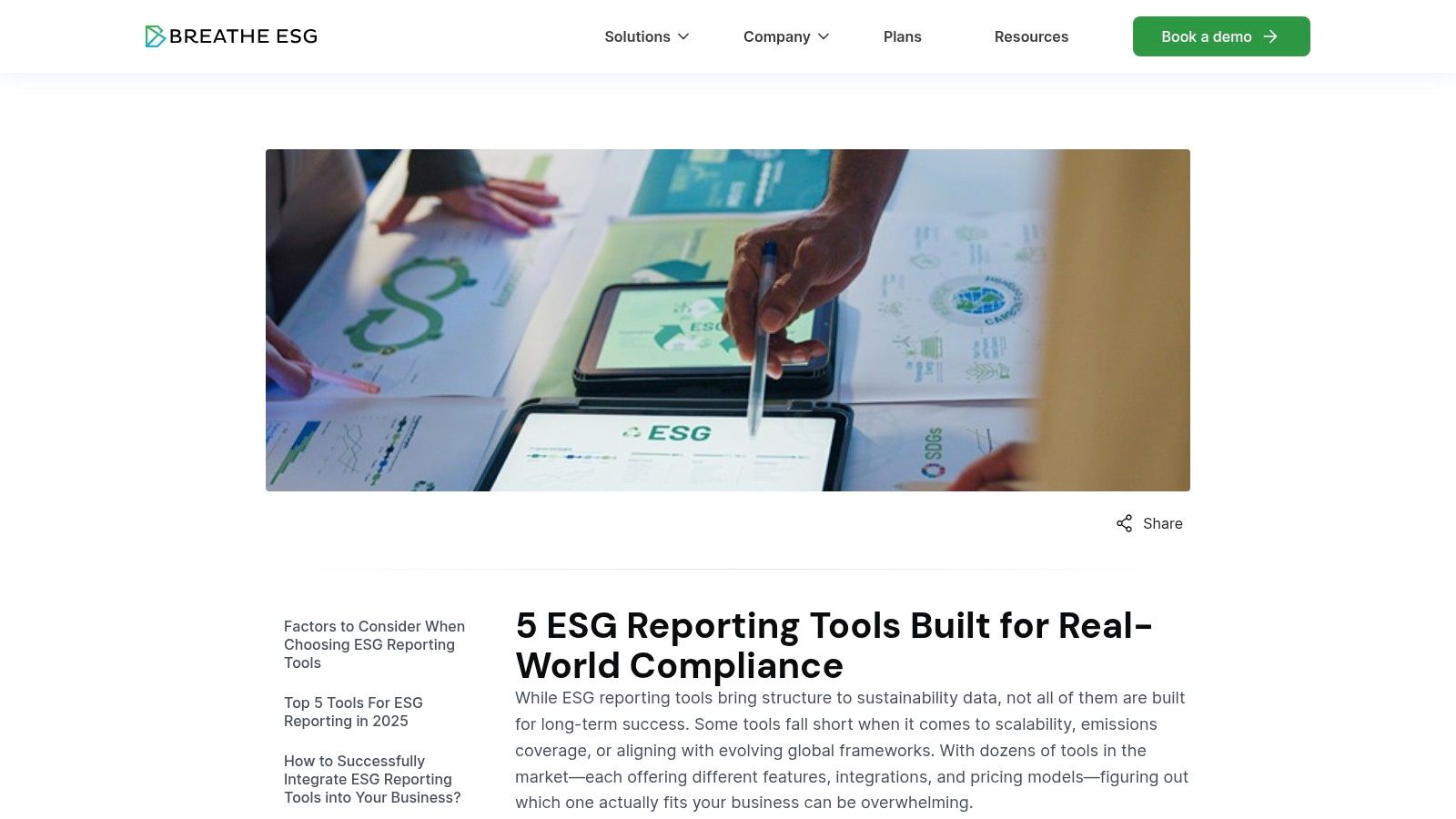
The platform is distinguished by its AI-powered automation, which not only assists in data processing but also provides predictive analytics to forecast emissions trends. For businesses looking for tools for tracking Scope 3 supplier emissions, Breathe ESG’s multi-framework reporting engine is a significant advantage, as it maps collected data to various standards like GRI, SASB, and TCFD automatically.
Key Features & Use Case
Breathe ESG’s unified data hub allows sustainability managers to consolidate ESG metrics from across departments and suppliers into a single source of truth. A common use case involves a compliance officer using the platform to generate granular emissions reports for different business units, ensuring each one meets its specific regulatory and voluntary reporting obligations without manual cross-referencing.
| Feature Highlights | Practical Application |
|---|---|
| Unified Data Hub | Consolidates ESG data for a holistic view of performance. |
| Multi-Framework Reporting | Automates mapping of metrics to global ESG standards. |
| AI-Powered Automation | Reduces manual effort and improves accuracy in disclosures. |
Access and Implementation
To gain access, companies must contact Breathe ESG through their website to schedule a demo and receive customised pricing. The implementation process involves integrating data sources, and while the platform is user-friendly, integrating with custom legacy systems may require additional setup time. The support team assists during onboarding, though users may need initial guidance to configure some of the more advanced dashboards to their specific needs.
12. DitchCarbon
DitchCarbon is a UK-based emissions intelligence company providing a specialised SaaS platform for measuring and managing Scope 3 emissions. It leverages artificial intelligence to automate data collection from suppliers and investments, offering a modern solution for businesses seeking greater accuracy and real-time insights into their value chain footprint. The platform is designed to process diverse data sources, such as invoices and supplier reports, to deliver granular emissions analysis.
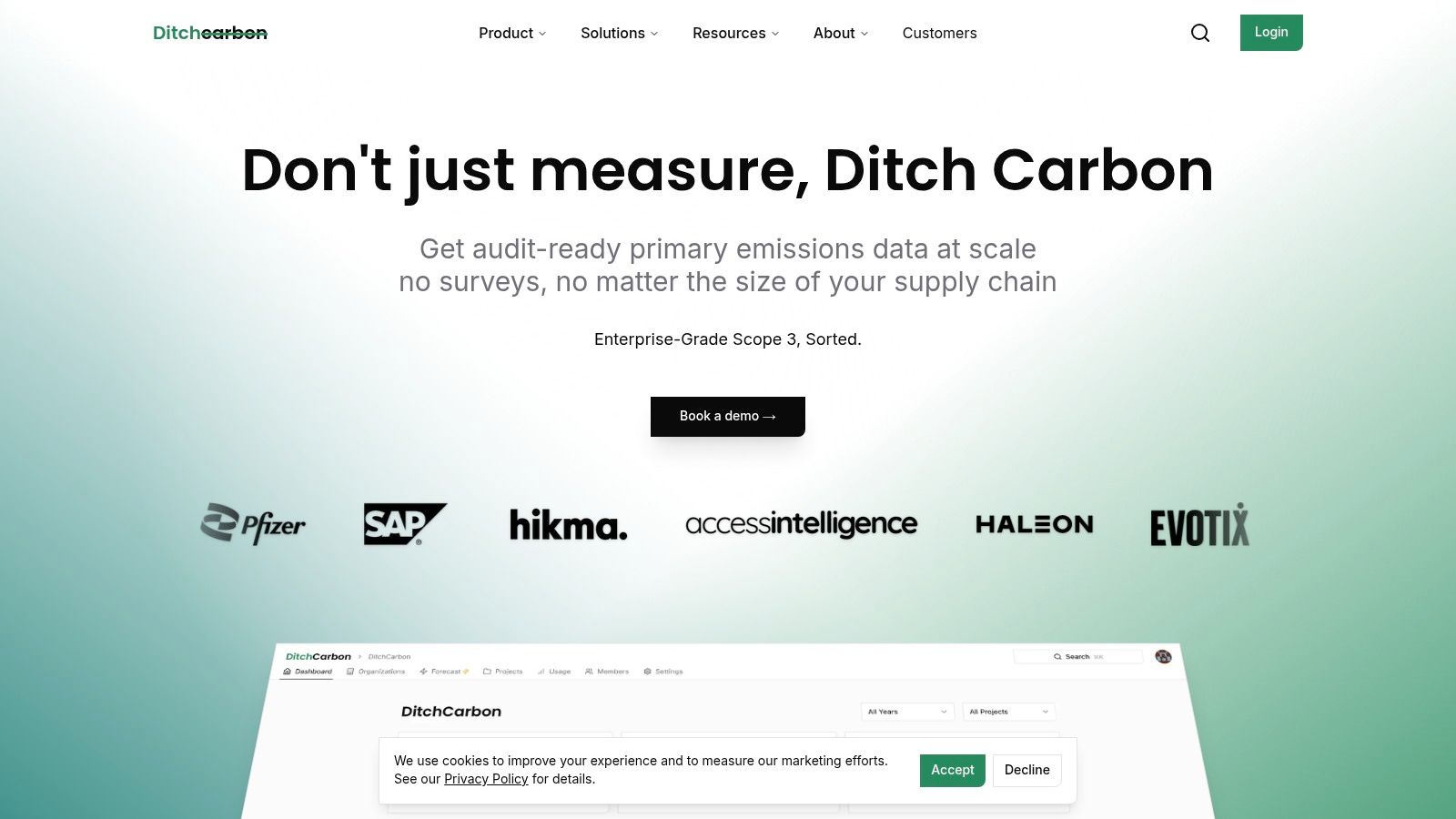
Its AI-driven approach to data extraction and classification makes it one of the more technologically advanced tools for tracking Scope 3 supplier emissions, particularly for organisations aiming to move beyond spend-based estimates towards more precise, activity-based data. This focus on data quality management helps ensure reporting aligns with major frameworks like GHG Protocol and supports credible decarbonisation strategies.
Key Features & Use Case
DitchCarbon’s platform is built to provide actionable intelligence through dynamic dashboards. A key use case involves a sustainability manager using the system to automatically calculate emissions from thousands of procurement invoices, identify carbon hotspots by product category, and model reduction scenarios. This enables data-driven engagement with suppliers to implement science-based targets.
| Feature Highlights | Practical Application |
|---|---|
| AI-Powered Data Extraction | Automates emissions calculations from invoices and supplier reports. |
| Granular Emissions Analysis | Breaks down carbon data by supplier, category, or individual product. |
| Scenario Modelling Tools | Allows businesses to forecast the impact of reduction initiatives. |
Access and Implementation
Organisations can get started by scheduling a demo through the DitchCarbon website to receive customised pricing and an implementation plan. The initial setup can be intensive, especially if integrating with multiple ERP systems, and may require some training to maximise the use of its advanced features. However, its primary benefit is reducing the long-term manual workload associated with supplier data management.
- Website: ditchcarbon.com
Scope 3 Supplier Emissions Tracking Tools Comparison
| Platform | Core Features / Capabilities | User Experience & Quality ★ | Value & Pricing 💰 | Target Audience 👥 | Unique Selling Points ✨ |
|---|---|---|---|---|---|
| 🏆 Carbonpunk | Real-time CO₂ tracking (95%+ accuracy), AI route optimization, automated audit-ready ESG reports | ★★★★★ High accuracy, user-centric design | Custom pricing, tailored for large enterprises | Large enterprises with complex supply chains | AI-driven actionable insights, real-time monitoring, strong data security |
| Plan A | Automated data collection, science-based targets, compliance support | ★★★★ User-friendly, suited for carbon accounting beginners | Affordable, regional focus (Czech Republic) | SMEs & mid-market in Czech Republic | Localized solutions, comprehensive regulatory compliance support |
| Sweep | Supplier data collection across 15 Scope 3 categories, collaborative tools | ★★★★ Enterprise-grade security (SOC, ISO 27001) | Enterprise pricing, free for suppliers | Large organizations with complex value chains | Supplier engagement, collaborative emissions reduction |
| Persefoni | Automated Scope 3 calc., finance-focused UI, built-in regulatory alignment | ★★★★ High accuracy, audit-ready reporting | Premium pricing, enterprise focus | Financial institutions & large enterprises | Finance-first approach, PwC partnership, strong compliance |
| Greenly | Automated supplier matching, LCA hotspot analysis, regulatory-ready reporting | ★★★★ Comprehensive footprint analytics | Mid-tier pricing | Businesses focused on supplier engagement & decarbonization | Lifecycle assessment focus, sustainable procurement insights |
| Sphera | Facility-level energy data input, multi-tier supply chain analysis | ★★★★ Improves data quality & supplier engagement | Enterprise-level pricing | Enterprises requiring deep supply chain insights | Precise energy use data, multi-tier supplier analysis |
| Emitwise | ML-driven real-time tracking, supplier integration, custom ESG dashboards | ★★★★ Real-time tracking, machine learning accuracy | Mid to enterprise pricing | Operations-heavy businesses & supply chains | Machine learning for emissions accuracy |
| Normative | AI-powered Scope 3 calc., large financial data processing | ★★★ Accessible, minimal manual input | Mid-tier pricing | Firms with limited resources or new carbon accounting | Minimal manual work, AI automation |
| Axiom | Comprehensive emissions tracking, supplier collaboration | ★★★ User-friendly, customizable | Mid-tier pricing | Businesses needing supplier collaboration | Easy-to-use footprint calculator, supplier data collaboration |
| CarbonTrail | Centralized SME partner workflows, AI-powered measurement | ★★★ Good for SMEs, verifiable data | Affordable for SMEs | Small and medium enterprises | SME focus, centralized emissions data collection |
| Breathe ESG | Unified ESG data hub, multi-framework reporting, AI-powered automation | ★★★★ Comprehensive, AI reduces manual effort | Enterprise pricing | Large enterprises with full ESG reporting needs | End-to-end ESG cycle automation |
| DitchCarbon | AI-powered Scope 3 data extraction, real-time dashboards | ★★★★ High data quality & scenario modeling | Mid to enterprise pricing | UK-based businesses focusing on suppliers & investments | Invoice data extraction, science-based target support |
Final Thoughts
Navigating the complex landscape of Scope 3 emissions can feel daunting, but the right technology transforms this challenge into a strategic opportunity. As we have explored, the market for tools for tracking Scope 3 supplier emissions is diverse and rapidly maturing. From AI-driven platforms like Carbonpunk and Normative that automate data collection from thousands of suppliers, to more specialised solutions like Sphera with its deep industry-specific datasets, there is a tool designed to meet nearly every organisational need.
The core takeaway is that moving beyond estimations to accurate, supplier-specific data is no longer a distant goal. Platforms such as Sweep and Plan A demonstrate the power of collaborative engagement, turning data collection into a value-added exercise for both your organisation and your supply chain partners. Similarly, tools like Greenly and Breathe ESG show that powerful carbon accounting can be accessible even for organisations just beginning their sustainability journey.
Selecting Your Path Forward
Choosing the right tool is less about finding a single "best" platform and more about identifying the best fit for your unique circumstances. Your decision should be guided by several key factors:
- Your Organisational Maturity: Are you just starting out and need a user-friendly platform with strong educational support, or are you a mature enterprise requiring deep customisation and integration with existing ERP and procurement systems?
- Your Supply Chain Complexity: A global, multi-tiered supply chain demands a tool with robust supplier engagement features and the ability to handle varied data formats, whereas a smaller, regional supply chain might prioritise simplicity and speed.
- Your Strategic Goals: Is your primary driver compliance with regulations like the CSRD, or are you focused on proactively identifying decarbonisation opportunities and risks within your value chain? Platforms like Persefoni excel in audit-ready reporting, while others are geared more towards strategic reduction planning.
From Measurement to Action
Ultimately, the goal of tracking emissions is to reduce them. The detailed data and insights gathered from these powerful software tools provide the critical foundation needed to build an effective decarbonisation strategy. Once emissions hotspots are accurately identified within your supply chain, you can move from measurement to meaningful action. At this stage, organisations can then implement advanced industrial energy saving strategies for 2025 to achieve tangible reductions and drive real environmental progress.
The journey to net zero is a marathon, not a sprint. By arming your organisation with the right tools for tracking Scope 3 supplier emissions, you are not just investing in software; you are investing in a more resilient, transparent, and sustainable future for your business and its entire value chain.
Ready to automate your Scope 3 data collection and turn compliance into a competitive advantage? Discover how Carbonpunk uses AI to provide precise, real-time emissions data from your entire supplier network. Visit Carbonpunk to see how our platform can streamline your ESG reporting and decarbonisation efforts today.